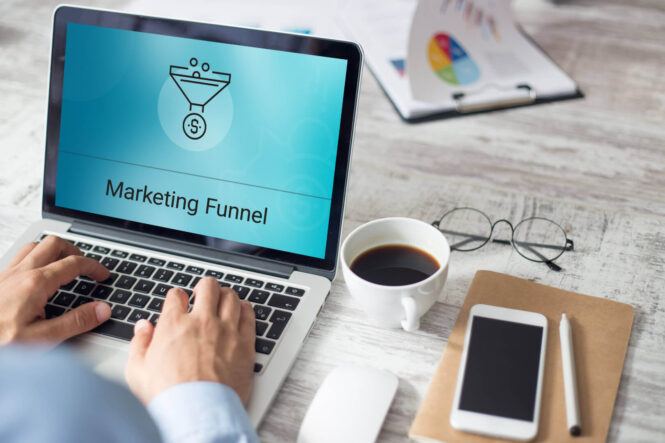A funnel, also known as a conversion funnel or sales funnel, is a journey that a potential customer goes through, starting with an initial awareness of a product or service and ultimately ending with a conversion, such as a purchase or a lead generation. The concept of a funnel is based on the idea that not all visitors to a website or marketing campaign will convert, and therefore the number of visitors will decrease as they move through the funnel stages.
The funnel stages typically include Awareness, Interest, Desire, Action and Retention. Awareness, being the first step, is the stage where the customer is first exposed to the product or service. Interest follows, where the customer starts to engage with the product or service and learn more about it. Desire, the next stage, is when the customer starts to develop a preference or intent to purchase. Action is when the customer makes a purchase or completes a lead generation form. And finally, Retention, where the customer is retained as a customer, either through repeat purchases or long-term engagement.
There are different types of funnels, such as lead generation funnels, sales funnels, event funnels, webinar funnels, product launch funnels, subscription funnels and membership funnels. Each type of funnel is designed to achieve a specific goal, such as generating leads, making sales, promoting events, or launching a new product.
Importance of funnels in business

Funnels are really important for businesses because they help turn website visitors into customers. A funnel is like a roadmap that guides people through the process of learning about your product or service and ultimately buying it. It’s a way to get people to take action and make a purchase or sign up for something.
The purpose of this article is to explain what funnels are, how they work and the different types of funnels that exist. We will also be comparing different funnel strategies and showing you real life examples of businesses that have used them successfully. Additionally, we will also be providing some tips and tricks on how to create and optimize funnels to boost your conversion rates. It is essential to create funnels diagrams for your business and you can do that with the help of online tools.
Comparison of Funnel Strategies

When it comes to funnel strategies, there are many different approaches that businesses can take. Two popular strategies are the traditional funnel and the reverse funnel.
The traditional funnel strategy is the most common approach and includes the stages of awareness, interest, desire, action and retention. This strategy starts by building awareness of the product or service, then moves on to generating interest, creating desire, and ultimately, getting the customer to take action and make a purchase.
The reverse funnel strategy, on the other hand, starts with the action stage and then moves backwards. This strategy is commonly used when a business is promoting an event or webinar, where the customer is asked to register for the event or webinar before they are provided with any information about it. This strategy aims to build interest and desire before the customer takes action.
Both strategies have their own set of advantages and disadvantages. The traditional funnel strategy is great for building trust and nurturing leads, but it can take longer to convert leads into customers. The reverse funnel strategy can be a great way to quickly build interest and generate leads, but it can be harder to build trust and nurture leads. Present your findings about funnels using the
Ultimately, the best strategy for a business will depend on the product or service being offered, the target audience, and the business’s overall goals. It’s important to test different strategies and see which one works best for your business. And to find out this you can create comparison charts.
Case Studies: Different funnel strategies

One example is an e-commerce business that implemented a traditional funnel strategy. They started by creating awareness for their products through social media ads and content marketing. Then, they generated interest by offering a lead magnet, such as a discount code, in exchange for an email address. Next, they created desire by sending targeted email campaigns with product recommendations and testimonials. Finally, they encouraged customers to take action by offering a limited-time sale. As a result of this strategy, the business saw a 30% increase in sales and a 50% increase in email subscribers.
Another example is a B2B business that implemented a reverse funnel strategy for a webinar they were hosting. They promoted the webinar through social media ads and email campaigns, but instead of providing information about the webinar beforehand, they only provided the date and time of the webinar and a registration link. They found that this approach generated a higher registration rate for the webinar and a higher percentage of attendees converted into paying customers.
These examples show how different funnel strategies can be tailored to different types of businesses and can result in different levels of success. It is important to test different strategies and see which one works best for your business.
Final thoughts

funnels are a powerful tool for businesses to turn website visitors into customers. By guiding potential customers through a journey, funnels help increase conversions and drive more sales. There are different types of funnels, such as lead generation funnels, sales funnels, event funnels, and product launch funnels, each one of them with a specific goal. Additionally, there are different funnel strategies, such as traditional funnel and reverse funnel, each one with its own set of advantages and disadvantages.
It is important for businesses to understand the target audience and tailor the funnels to their needs, use A/B testing to optimize the funnels, and use retargeting and analytics to track the performance. By following these best practices and by understanding the different types of funnels and strategies, businesses can increase their conversion rates and drive more sales. As you have seen in the case studies provided, different strategies can work differently for different types of businesses, it is important to experiment and find the one that works best for you. To know more about online sales funnels read this article.
 Imagup General Magazine 2024
Imagup General Magazine 2024



